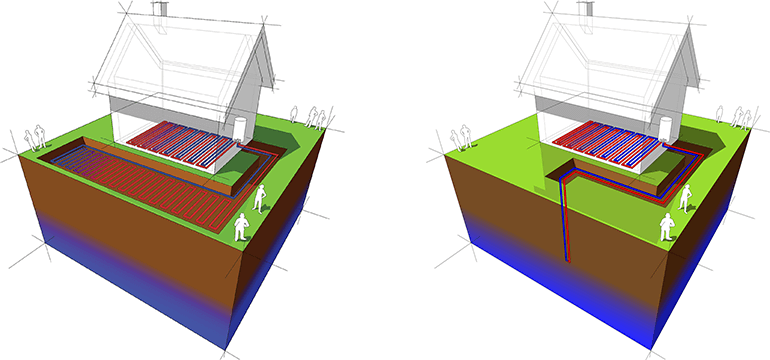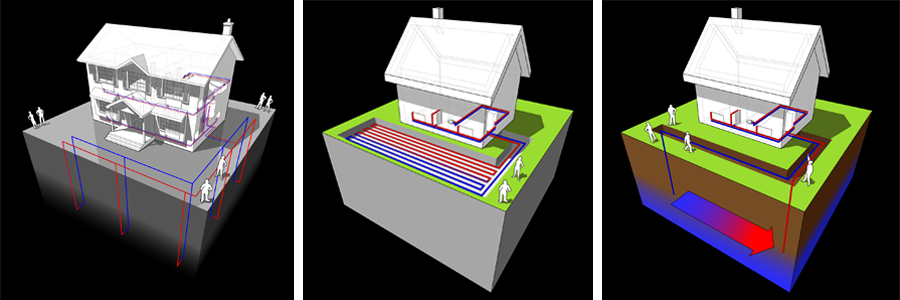Geothermal (or ground source) heat pumps are electrical appliances that run a water mixture through underground piping. Instead of burning fossil fuels or using electrical resistance, they use a refrigerant and heat exchanger. Heat is moved from the ground for heating, or into the ground for cooling, and the resulting warm air is distributed through the building. This is similar to a refrigerator or air conditioner, except that heat pumps can move heat in either direction to provide both heating and cooling.
Geothermal heat pumps differ from air source heat pumps in that they use heat from the ground instead of from outdoor air. While the installation process is more involved and the upfront cost is higher, geothermal pumps are more efficient than air source. This results in lower operating costs and greater savings over the lifetime of the system.
Since the ground maintains a stable temperature year-round, geothermal heat pumps are 350-500% more efficient than fossil fuel or traditional electrical resistance heat, while also exceeding the efficiency of central air conditioners.

There is a wide range of geothermal system models and configurations that can match the needs of your building. Each geothermal system consists of an outdoor ground loop and indoor components.
The ground loop serves as the heat exchange surface for your heat pump where heat is absorbed from or transferred into the ground. A home will typically need several hundred to a thousand feet of piping in the ground loop to provide enough heat in the coldest part of the year. Most ground loops are divided into “closed” and “open” loops:
Closed loop systems are the most common option used in New York State, using piping buried into the ground that circulates a mixture of water and environmentally-friendly antifreeze for heat transfer. This heat transfer fluid is not directly exposed to the environment, and the piping itself is typically made out of high-density polyethylene (HDPE) and is warrantied against leaks for decades. Closed loop systems can be installed vertically, where piping is run through multiple boreholes drilled several hundred feet into the ground, or horizontally where piping is run through multiple trenches approximately 6 feet deep and several hundred feet long.
Open loop systems can be installed where there is an available source of groundwater available on the property from a well. Instead of circulating an antifreeze mixture, an open loop system will pump groundwater into the heat pump unit indoors to extract heat before being safely returned to the ground. Open loop systems are typically cheaper to install and more efficient (due to the more consistent year-round temperature of groundwater), though they require additional pumping energy, a readily-available source of clean groundwater, and may require additional permitting or environmental review.

Other options are available depending on your site: for example, if you have a large pond on your property, you could install a closed loop system using the pond water for heat transfer!
Geothermal systems also have an indoor heat pump unit that transfers heat out of or into the ground loop. The most common options are “water-to-air” or “water-to-water,” selected based on the way your building distributes heat.
Halco: Whole Home Retrofit Case Study
Tuesday, May 12
NP Environmental: Hydronic Geothermal with Heat & AC
May 14, 2020
ACES Energy: Geothermal Case Study
May 26, 2020